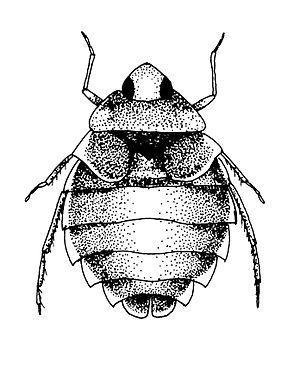Ground bugs
| Ground bugs | ||||||||||||
|---|---|---|---|---|---|---|---|---|---|---|---|---|

Illustration of a ground bug ( Aphelocheirus aestivalis ) |
||||||||||||
| Systematics | ||||||||||||
|
||||||||||||
| Scientific name of the family | ||||||||||||
| Aphelocheiridae | ||||||||||||
| Fever , 1851 | ||||||||||||
| Scientific name of the genus | ||||||||||||
| Aphelocheirus | ||||||||||||
| Westwood , 1833 |
The ground bugs ( Aphelocheirus ) are the only genus of the family Aphelocheiridae from the partial order of the water bugs (Nepomorpha). They occur exclusively in the Old World with over 60 species .
features
Ground bugs grow to be 3.5 to 11.5 millimeters long. With their flattened and egg-shaped body, they resemble the closely related swimming bugs (Naucoridae). However, they differ from these mainly in their relatively long labia and antennae .
Her head is drawn forward and pulled back into the pronotum protruding around it . The slim, four-part antennae are thread-shaped. The rather long labium extends well to the metasternum. Its second segment is very short, the third very long, and the fourth less than half as long as the third. A wing polymorphism can often be observed in the bugs; there are individuals of the same species with well-developed wings alongside those whose wings are reduced. The tarsi of all legs have a pair of equally developed claws. The scent glands on the metathorax are missing, the dorsal scent glands on the abdomen are always developed. The posterior, lateral (posterolateral) corners of the conexivia are often thorn-shaped. The abdomen has simple dorsal and ventral chitin plates. The abdomen of the thorax and the abdomen have a plastron . This means that, unlike other water bugs, the bugs can live submerged for their entire life, as the oxygen dissolved in the water can be used directly. In contrast to all other types of water bugs, the spiracles on the second to seventh abdomen segment are bordered by rosettes. The second sternum on the abdomen bears a pair of sensory organs sublaterally, the function of which is so far unknown. The ground bugs also have pressure receptors.
Not only the adults , but also the eggs and the older nymphs have a plastron for breathing. Younger nymphs must like z. B. the row bugs (Corixidae) absorb oxygen directly from the body surface.
Occurrence
The ground bugs are mainly paleotropic from Africa to the north of Queensland and also on Madagascar . A few species are found in the Palearctic . The animals colonize benthos , i.e. the bottom zone of rivers and lakes, and there are species that can even live several meters below the surface of the water. Others are relatively cold tolerant.
Taxonomy and systematics
The taxon was described as a family by Franz Xaver Fieber in 1851, but was regarded by subsequent authors as both a family and a subfamily of the swimming bugs (Naucoridae), without there being any reliable classification for one or the other point of view. Even that was monophyly temporarily called into question.
The following types occur in Europe; of which only the root bug ( Aphelocheirus aestivalis ) is also widespread in Central Europe :, two other species are endemic to the Iberian Peninsula
- Ground bug ( Aphelocheirus aestivalis ) ( Fabricius , 1794)
- Aphelocheirus murcius Nieser & Millan , 1989
- Aphelocheirus occidentalis Nieser & Millan , 1989
supporting documents
Individual evidence
- ↑ a b Ekkehard Wachmann , Albert Melber, Jürgen Deckert: Bugs. Volume 1: Cimicomorpha: Dipsocoromorpha, Nepomorpha, Gerromorpha, Leptopodomorpha, Cimicomorpha (part 1) (= The animal world of Germany and the adjacent sea parts according to their characteristics and according to their way of life . 77th part). Goecke & Evers, Keltern 2006, ISBN 3-931374-49-1 , p. 49 .
- ↑ a b c d R.T. Schuh, JA Slater: True Bugs of the World (Hemiptera: Heteroptera). Classification and Natural History. Cornell University Press, Ithaca, New York, 1995, pp. 126f.
- ↑ Aphelocheiridae. Fauna Europaea, accessed December 24, 2013 .
- ↑ Jose-Antonio Carbonellm, Pedro Abellan, Paula Arribas, Jean Francois Elder, Andres Millan (2011): The genus Aphelocheirus Westwood, 1833 (Hemiptera: Aphelocheiridae) in the Iberian Peninsula. Zootaxa 2771: 1-16.
literature
- RT Schuh, JA Slater: True Bugs of the World (Hemiptera: Heteroptera). Classification and Natural History. Cornell University Press, Ithaca, New York, 1995.
- Ekkehard Wachmann , Albert Melber, Jürgen Deckert: Bugs. Volume 1: Cimicomorpha: Dipsocoromorpha, Nepomorpha, Gerromorpha, Leptopodomorpha, Cimicomorpha (part 1) (= The animal world of Germany and the adjacent sea parts according to their characteristics and according to their way of life . 77th part). Goecke & Evers, Keltern 2006, ISBN 3-931374-49-1 .